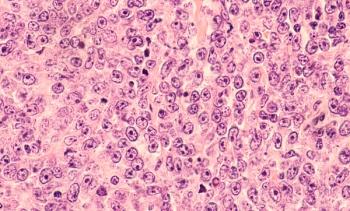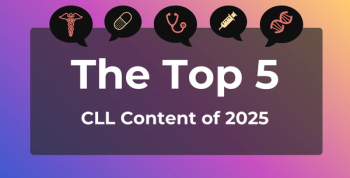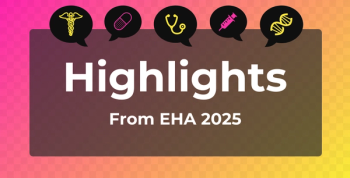
Obe-Cel Is Effective Irrespective of Age in Relapsed/Refractory B-ALL
Obecabtagene autoleucel showed over 70% response rates in relapsed/refractory B-cell acute lymphoblastic leukemia (B-ALL), demonstrating efficacy across all age groups in recent trials.
This article originally
Obecabtagene autoleucel (obe-cel; Aucatzyl) led to a complete response (CR)/CR with incomplete hematologic recovery (CRi) rate in more than 70% of all age-stratified patient subgroups with relapsed/refractory B-cell acute lymphoblastic leukemia (B-ALL), according to data from a post hoc analysis of the phase 1b/2 FELIX trial (NCT04404660) that were presented at the
With 32.8 months of follow-up, the CR/CRi rates were 72.2% (95% CI, 60.9%-81.7%), 87.5% (95% CI, 74.8%-95.3%), 80.5% (95% CI, 72.0%-87.4%), and 96.0% (95% CI, 79.6%-99.9%) in patients less than 55 years (n = 79), 55 years or older (n = 48), 26 years or older (n = 113), and 65 years or older (n = 25), respectively.
Minimal residual disease (MRD)–negative remissions at a sensitivity of 10–6 leukemic cells were achieved by month 3 in 84.2% (n = 32/38), 83.3% (n = 32/38), 85.2% (n = 52/61), and 88.2% (n = 15/17) of responders aged less than 55, 55 or older, 26 or older, and 65 or older who had at least 1 post-infusion next-generation sequencing result, respectively.
“Following treatment with obe-cel, minimal differences in objective response rate, event-free survival [EFS], and overall survival [OS] was observed in patients aged < 55 years and ≥ 55 years. This was also consistent in the age groups of interest [≥ 26 years and ≥ 65 years],” Bijal D. Shah, MD, lead study author and associate member in the Department of Malignant Hematology at Moffitt Cancer Center in Tampa, Florida, stated.
Obe-Cel Background and FELIX Trial History
Obe-cel is an autologous CAR T-cell therapy that has a fast off-rate CD19 binder and has shown a favorable benefit-risk profile in patients with relapsed/refractory B-ALL based on prior data from the FELIX trial.2,3
The
Updated data from the trial with approximately 3 years of follow-up demonstrated that 38.4% of responders maintained their remission without consolidative stem cell transplant (SCT) or other treatment.5 To better understand the long-term activity of the agent in different age groups, investigators conducted a post hoc analysis of the FELIX trial.1
The study had enrolled patients at least 18 years of age with relapsed/refractory B-ALL. Following screening, patients underwent leukapheresis and bridging therapy, during which obe-cel was manufactured. Two bone marrow biopsies were required during screening and prior to lymphodepletion, although this is not mandated in routine practice.
Patients then received lymphodepletion with 30 mg/m2 of fludarabine and 500 mg/m2 of cyclophosphamide. Tumor burden–guided dosing was split between days 1 and 10 with a total target dose of 410 x 106 CAR T cells before patients entered efficacy and safety follow-up.
The primary end points of the study were the CR/CRi rate per independent response review committee assessment and MRD-negativity rate at a sensitivity of less than 10–4 leukemic cells. Secondary end points included duration of response, EFS, OS, safety, CAR T-cell expansion, and persistence.
In the present analysis, patients were stratified into 1 of 4 age groups: less than 55 years, 55 years or older, 26 years or older, and 65 years or older.
“All the groups were heavily pretreated, but focusing on blinatumomab [Blincyto], inotuzumab ozogamicin [Besponsa], and prior transplant, you can see a slightly lower rate of blinatumomab use in those over the age of 65 relative to their younger counterparts. Inotuzumab use, interestingly, was more commonly delivered for our older patients, and transplant, perhaps expectedly, was lower in this older age patient population,” Shah said.
He also noted that the proportion of patients with greater than 75% bone marrow blasts at lymphodepletion was similar in all the age-stratified subgroups, with nearly one-third of patients showcasing this high-risk characteristic.
Age-Stratified Efficacy Outcomes
Additional findings indicated a sizable proportion of patients who remained in remission without subsequent therapy across age groups. These rates were 33.3% (n = 19/57), 45.2% (n = 19/42), 39.6% (n = 36/91), and 33.3% (n = 8/24) in the less than 55 years, 55 years or older, 26 years or older, and 65 years or older subgroups, respectively. Alternatively, 1.8% (n = 1), 14.3% (n = 6), 7.7% (n = 7), and 12.5% (n = 3) of patients in the respective arms died. “This rate, in my opinion, highlights the feasibility of delivery even to our older patients,” Shah said.
With respect to EFS, which was censored for consolidative SCT, the median values were 14.3 months (95% CI, 6.0-not evaluable [NE]), 11.7 months (95% CI, 6.6-NE), 12.3 months (95% CI, 8.1-NE), and 9.1 months (95% CI, 6.6-NE) in the less than 55 years, 55 years or older, 26 years or older, and 65 years or older subgroups, respectively.
The respective 12-month EFS rates were 53.1% (95% CI, 40.3%-64.3%), 46.4% (95% CI, 31.2%-60.3%), 50.1% (95% CI, 39.8%-59.5%), and 40.6% (95% CI, 20.1%-60.2%). The respective 24-month EFS rates were 42.8% (95% CI, 30.0%-55.0%), 43.3% (95% CI, 28.2%-57.6%), 43.7% (95% CI, 33.4%-53.5%), and 34.8% (95% CI, 15.5%-55.0%).
The median OS values, also censored for transplant, were 16.7 months (95% CI, 11.5-28.8), 23.8 months (95% CI, 11.7-NE), 17.1 months (95% CI, 13.2-28.8), and 23.8 months (95% CI, 8.9-NE) in the less than 55 years, 55 years or older, 26 years or older, and 65 years or older subgroups, respectively.
The respective 12-month OS rates were 59.5% (95% CI, 47.8%-69.4%), 64.6% (95% CI, 49.4%-76.3%), 62.8% (95% CI, 53.2%-71.0%), and 64.0% (95% CI, 42.2%-79.4%). The respective 24-month OS rates were 44.1% (95% CI, 33.0%-54.7%), 49.3% (95% CI, 34.4%-62.6%), 45.5% (95% CI, 36.1%-54.5%), and 46.8% (95% CI, 26.3%-64.9%).
Safety Findings According to Age
“In all investigated age groups, incidence of grade 3 or greater cytokine release syndrome [CRS] and immune effector cell–associated neurotoxicity syndrome [ICANS] was low,” Shah said.
In patients less than 55 years of age, the rate of any-grade CRS was 64.6% (grade ≥3, 2.5%), and the median time to onset was 9.0 days (range, 1-23). The rate of any-grade ICANS was 15.2% (grade ≥3, 5.1%), and the median time to onset was 18.0 days (range, 1-31). The rates of severe infections, unresolved grade 3 or greater neutropenia or thrombocytopenia at month 3, and treatment-related mortality within 3 months of infusion were 53.2%, 28.1%, and 0%, respectively.
In patients 55 years of age or older, the rate of any-grade CRS was 75.0% (grade ≥ 3, 2.1%), and the median time to onset was 8.0 days (range, 1-14). The rate of any-grade ICANS was 35.4% (grade ≥ 3, 10.4%), and the median time to onset was 11.0 days (range, 2-22). The rates of severe infections, unresolved grade 3 or greater neutropenia or thrombocytopenia at month 3, and treatment-related mortality within 3 months of infusion were 58.3%, 9.5%, and 4.2%, respectively.
In patients at least 26 years of age, the rate of any-grade CRS was 69.9% (grade ≥ 3, 2.7%), and the median time to onset was 9.0 days (range, 1-23). The rate of any-grade ICANS was 24.8% (grade ≥ 3, 7.1%), and the median time to onset was 12.5 days (range, 1-31). The rates of severe infections, unresolved grade 3 or greater neutropenia or thrombocytopenia at month 3, and treatment-related mortality within 3 months of infusion were 56.6%, 19.8%, and 1.8%, respectively.
In patients 65 years of age or older, the rate of any-grade CRS was 72.0% (grade ≥ 3, 4.0%), and the median time to onset was 8.0 days (range, 1-12). The rate of any-grade ICANS was 48.0% (grade ≥ 3, 16.0%), and the median time to onset was 11.0 days (range, 2-22). The rates of severe infections, unresolved grade 3 or greater neutropenia or thrombocytopenia at month 3, and treatment-related mortality within 3 months of infusion were 48.0%, 8.3%, and 8.0%, respectively.
Main Takeaway
“These findings indicate that obe-cel has a positive benefit-risk profile regardless of patient age, including in older adults with relapsed/refractory B-ALL,” Shah concluded.
Disclosures: No disclosures were listed for Shah.
References
- Shah BD, Yallop D, Jabbour E, et al. Efficacy and safety outcomes of obecabtagene autoleucel (obe-cel) stratified by age in patients with relapsed/refractory B-cell acute lymphoblastic leukemia (r/r B-ALL). Presented at: 2025 European Hematology Association Congress; June 12-15, 2025; Milan, Italy. Abstract S114.
- Roddie C, Sandhu KS, Tholouli E, et al. Obecabtagene autoleucel in adults with B-cell acute lymphoblastic leukemia. N Engl J Med. 2024;391(23):2219-2230. doi:10.1056/NEJMoa2406526
- Yallop D, Jabbour E, Barba P, et al. Safety, efficacy and CAR T-cell persistence of obecabtagene autoleucel (obe-cel) in patients ≥55 years old, with relapsed or refractory B-cell acute lymphoblastic leukemia (r/r B-ALL). Presented at: 51st Annual EBMT Meeting; March 30-April 2, 2025; Florence, Italy. Abstract B216.
- FDA approves obecabtagene autoleucel for adults with relapsed or refractory B-cell precursor acute lymphoblastic leukemia. FDA. November 8, 2024. Accessed July 10, 2025. https://www.fda.gov/drugs/resources-information-approved-drugs/fda-approves-obecabtagene-autoleucel-adults-relapsed-or-refractory-b-cell-precursor-acute
- Park JH, Roddie C, Tholouli E, et al. Can CAR T-cell therapy be a definitive treatment for adult r/r B-ALL without transplant? Long-term findings and predictors of sustained remission for obecabtagene autoleucel. Presented at: 2025 European Hematology Association Congress; June 12-15, 2025; Milan, Italy. Abstract S113.
Newsletter
Stay ahead of policy, cost, and value—subscribe to AJMC for expert insights at the intersection of clinical care and health economics.







































